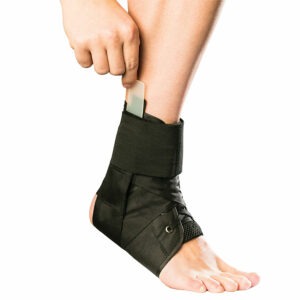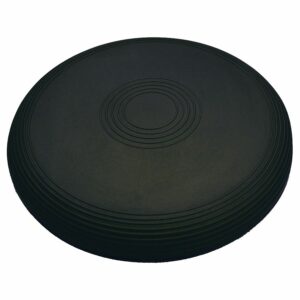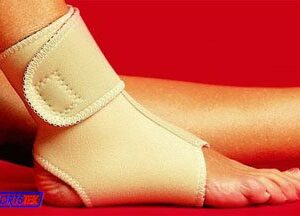Tarsal Tunnel Syndrome
Updated:
(Also known as Posterior Tibial Nerve Entrapment)
What is tarsal tunnel syndrome?
The tarsal tunnel is a groove which lies at the inner aspect of the ankle, behind the bony prominence known as the medial malleolus (figure 1). A nerve known as the posterior tibial nerve lies within this groove and may become compressed due to trauma such as rolling the ankle or due to repetitive strain associated with an excessively pronated (flat) foot. When this nerve becomes compressed, the condition is known as tarsal tunnel syndrome.
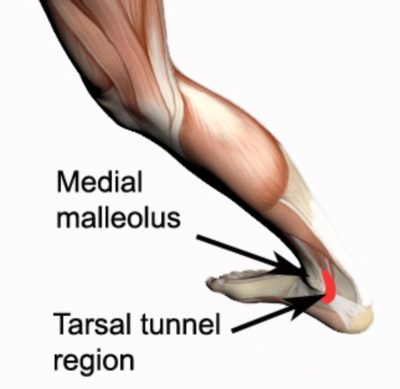
Signs and symptoms of tarsal tunnel syndrome
Patients with tarsal tunnel syndrome typically experience pain radiating into the arch of the foot, heel and occasionally the toes. There may also be pins and needles or numbness on the sole of the foot. Symptoms are typically worse during weight bearing activity such as walking, standing or running.
Diagnosis of tarsal tunnel syndrome
A thorough subjective and objective examination from a physiotherapist may be sufficient to diagnose tarsal tunnel syndrome. Diagnosis can be confirmed with nerve conduction studies.
Treatment for tarsal tunnel syndrome
A physiotherapy program is the first line of treatment for patients with this condition. The success rate of treatment is largely dictated by patient compliance. One of the key components of treatment is that the patient rests sufficiently from any activity that increases their pain until they are symptom free (crutches may be required). This allows the body to begin the healing process in the absence of further tissue damage. Once the patient can perform these activities pain free, a gradual return to these activities is indicated provided there is no increase in symptoms.
Ignoring symptoms or adopting a ‘no pain, no gain’ attitude is likely to lead to the condition becoming chronic. Once chronic, healing slows significantly resulting in markedly increased recovery times and an increased likelihood of future recurrence. Immediate appropriate treatment in all patients with tarsal tunnel syndrome is vital to ensure an optimal outcome.
Following the R.I.C.E. Regime particularly with regular icing and anti-inflammatory medication may help to significantly reduce inflammation in the initial phase of this condition. A graduated flexibility, strength and balance program under direction from a physiotherapist is important to ensure an optimal outcome
In the final stages of rehabilitation, a gradual return to activity or sport should occur under guidance from the treating practitioner and provided there is no increase in symptoms.
Contributing factors to the development of tarsal tunnel syndrome
There are several factors which can predispose patients to developing tarsal tunnel syndrome. These need to be assessed and corrected with direction from the treating physiotherapist and may include:
- poor foot biomechanics (especially flat feet)
- inappropriate footwear
- joint stiffness
- muscle weakness
- poor balance
- inappropriate or excessive training or activity
Physiotherapy for tarsal tunnel syndrome
Physiotherapy treatment is vital to hasten the healing process, ensure an optimal outcome and reduce the likelihood of injury recurrence in all patients with tarsal tunnel syndrome. Treatment may comprise:
- electrotherapy (e.g. ultrasound)
- joint mobilization
- taping or bracing
- the use of crutches
- ice or heat treatment
- biomechanical correction
- exercises to improve flexibility, strength and balance
- education
- activity modification advice
- a gradual return to activity program
Other intervention for tarsal tunnel syndrome
Despite appropriate physiotherapy management, some patients with tarsal tunnel syndrome do not improve adequately. When this occurs the treating physiotherapist or doctor can advise on the best course of management. This may include review with a podiatrist for possible orthotics, corticosteroid and anaesthetic injection into the tarsal tunnel or review by a specialist who will advise on any procedures that may be appropriate to improve the condition. Occasionally, decompressive surgery is required to alleviate pressure on the posterior tibial nerve.
Exercises for tarsal tunnel syndrome
The following exercises are commonly prescribed to patients with tarsal tunnel syndrome. You should discuss the suitability of these exercises with your physiotherapist prior to beginning them. Generally, they should be performed 3 times daily and only provided they do not cause or increase symptoms.
Foot and Ankle Up and Down
Move your foot and ankle up and down as far as possible and comfortable without pain (figure 2). Repeat 10 – 20 times provided there is no increase in symptoms.
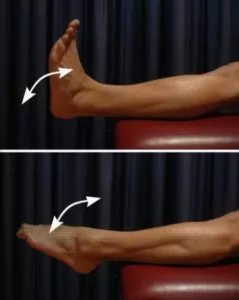
Foot and Ankle In and Out
Move your foot and ankle in and out as far as possible and comfortable without pain (figure 3). Repeat 10 – 20 times provided there is no increase in symptoms.
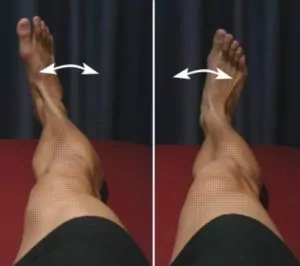
Foot and Ankle Circles
Move your foot and ankle in a circle as large as possible and comfortable without pain (figure 4). Repeat 10 times in each direction provided there is no increase in symptoms.
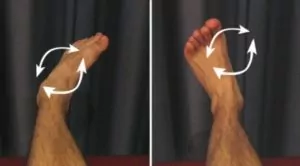
Figure 4 – Foot and Ankle Circles
Physiotherapy products for tarsal tunnel syndrome
Some of the most commonly recommended products by physiotherapist to hasten healing and speed recovery in patients with this condition include:
To purchase physiotherapy products for tarsal tunnel syndrome click on one of the above links or visit the PhysioAdvisor Shop.
More information
- View more Ankle Stretches.
- View Ankle Strengthening Exercises.
- View Balance Exercises.
- View Ankle Taping Techniques.
Find a Physio for tarsal tunnel syndrome
Find a Physiotherapist in your local area who can treat tarsal tunnel syndrome.

Link to this Page
If you would like to link to this article on your website, simply copy the code below and add it to your page:
<a href="https://physioadvisor.com.au/injuries/ankle/tarsal-tunnel-syndrome”>Tarsal Tunnel Syndrome – PhysioAdvisor.com</a><br/>PhysioAdvisor offers detailed physiotherapy information on Tarsal Tunnel Syndrome including: symptoms, causes, diagnosis, treatment, exercises, physiotherapy products and more...
Return to the top of Tarsal Tunnel Syndrome.

